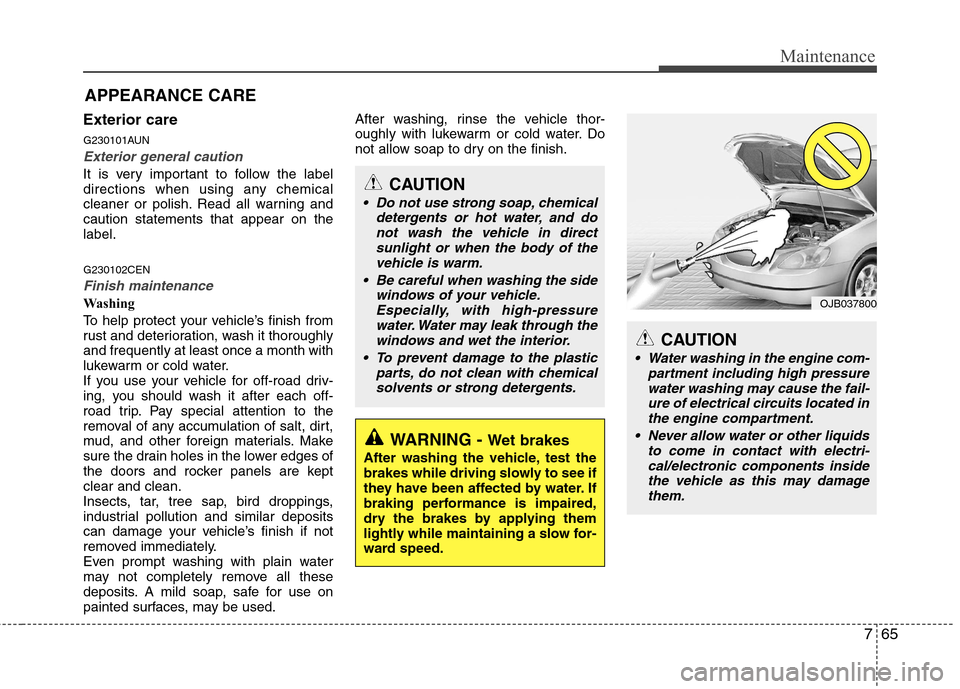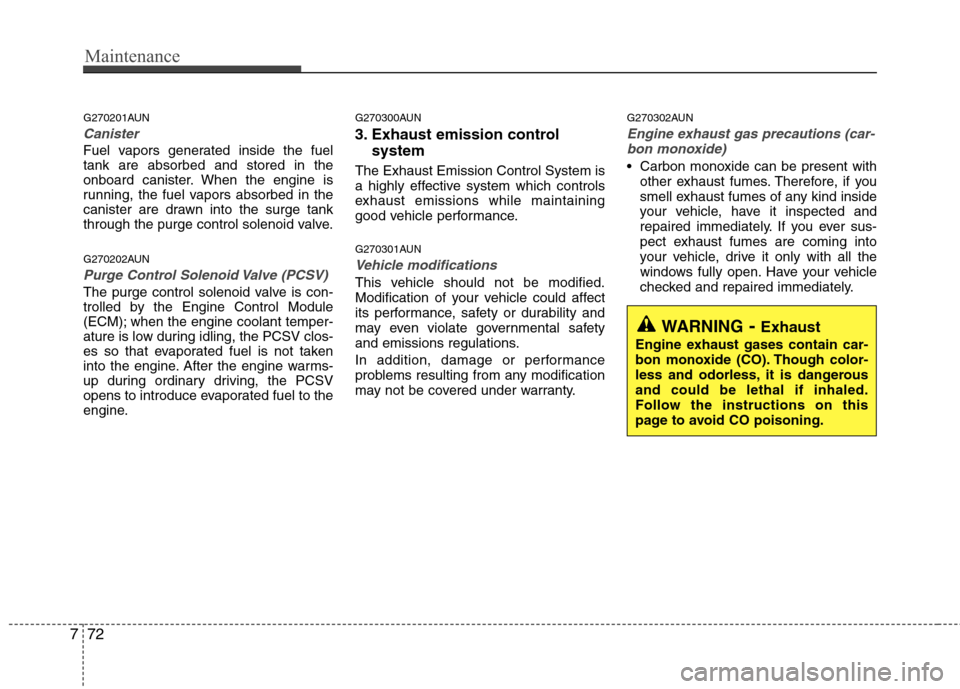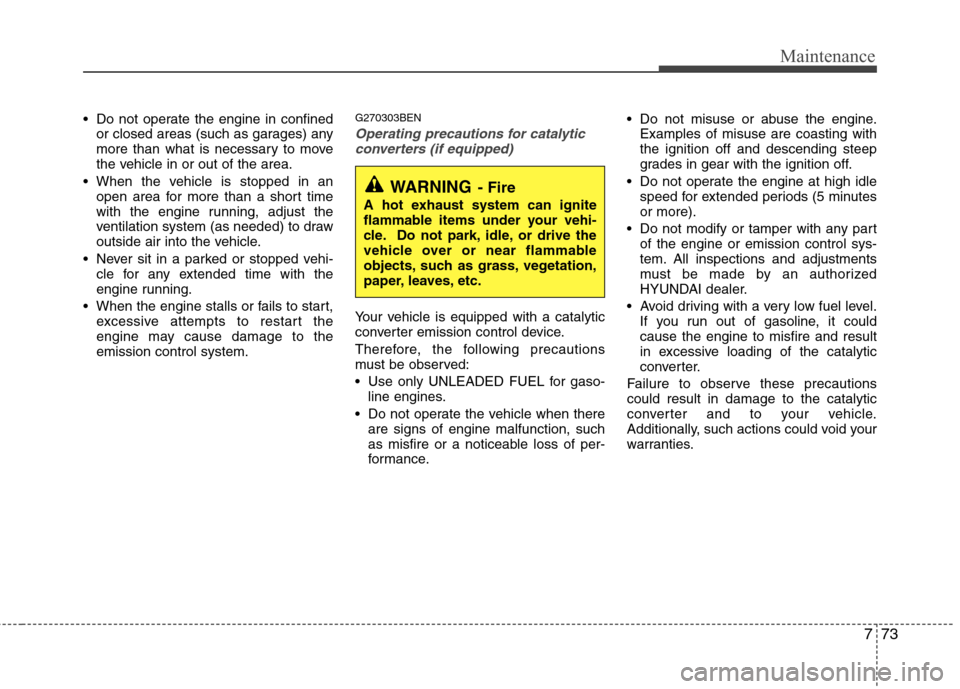Page 311 of 346
757
Maintenance
Engine compartment sub fuse panel (Diesel engine)
Description Fuse rating Protected component
GLOW 80A Glow plug relay
PTC 1 40A PTC heater relay #1
PTC 2 40A PTC heater relay #2
PTC 3 40A PTC heater relay #3
ABS 1 40A ABS/ESP control module
ABS 2 40A ABS/ESP control module
GLOW 10A ECM (D4BH)
Page 319 of 346

765
Maintenance
Exterior care
G230101AUN
Exterior general caution
It is very important to follow the label
directions when using any chemical
cleaner or polish. Read all warning andcaution statements that appear on thelabel. G230102CEN
Finish maintenance
Washing
To help protect your vehicle’s finish from
rust and deterioration, wash it thoroughlyand frequently at least once a month with
lukewarm or cold water.
If you use your vehicle for off-road driv-
ing, you should wash it after each off-
road trip. Pay special attention to the
removal of any accumulation of salt, dirt,
mud, and other foreign materials. Make
sure the drain holes in the lower edges of
the doors and rocker panels are keptclear and clean.
Insects, tar, tree sap, bird droppings,
industrial pollution and similar deposits
can damage your vehicle’s finish if not
removed immediately.
Even prompt washing with plain water
may not completely remove all these
deposits. A mild soap, safe for use on
painted surfaces, may be used.After washing, rinse the vehicle thor-
oughly with lukewarm or cold water. Do
not allow soap to dry on the finish.
APPEARANCE CARE
WARNING -
Wet brakes
After washing the vehicle, test the
brakes while driving slowly to see if
they have been affected by water. If
braking performance is impaired,
dry the brakes by applying them
lightly while maintaining a slow for-
ward speed.
OJB037800
CAUTION
Do not use strong soap, chemical detergents or hot water, and donot wash the vehicle in directsunlight or when the body of thevehicle is warm.
Be careful when washing the side windows of your vehicle.Especially, with high-pressurewater. Water may leak through thewindows and wet the interior.
To prevent damage to the plastic parts, do not clean with chemicalsolvents or strong detergents.
CAUTION
Water washing in the engine com- partment including high pressurewater washing may cause the fail-
ure of electrical circuits located inthe engine compartment.
Never allow water or other liquids to come in contact with electri-
cal/electronic components inside the vehicle as this may damagethem.
Page 326 of 346

Maintenance
72
7
G270201AUN
Canister
Fuel vapors generated inside the fuel tank are absorbed and stored in the
onboard canister. When the engine is
running, the fuel vapors absorbed in the
canister are drawn into the surge tank
through the purge control solenoid valve.
G270202AUN
Purge Control Solenoid Valve (PCSV)
The purge control solenoid valve is con-
trolled by the Engine Control Module
(ECM); when the engine coolant temper-
ature is low during idling, the PCSV clos-
es so that evaporated fuel is not taken
into the engine. After the engine warms-
up during ordinary driving, the PCSV
opens to introduce evaporated fuel to the
engine. G270300AUN
3. Exhaust emission control
system
The Exhaust Emission Control System is
a highly effective system which controls
exhaust emissions while maintaining
good vehicle performance.
G270301AUN
Vehicle modifications
This vehicle should not be modified.
Modification of your vehicle could affect
its performance, safety or durability and
may even violate governmental safety
and emissions regulations.
In addition, damage or performance
problems resulting from any modification
may not be covered under warranty. G270302AUN
Engine exhaust gas precautions (car-
bon monoxide)
Carbon monoxide can be present with other exhaust fumes. Therefore, if you
smell exhaust fumes of any kind inside
your vehicle, have it inspected and
repaired immediately. If you ever sus-
pect exhaust fumes are coming into
your vehicle, drive it only with all the
windows fully open. Have your vehicle
checked and repaired immediately.
WARNING - Exhaust
Engine exhaust gases contain car-
bon monoxide (CO). Though color-
less and odorless, it is dangerousand could be lethal if inhaled.
Follow the instructions on this
page to avoid CO poisoning.
Page 327 of 346

773
Maintenance
Do not operate the engine in confinedor closed areas (such as garages) any
more than what is necessary to move
the vehicle in or out of the area.
When the vehicle is stopped in an open area for more than a short time
with the engine running, adjust the
ventilation system (as needed) to draw
outside air into the vehicle.
Never sit in a parked or stopped vehi- cle for any extended time with the
engine running.
When the engine stalls or fails to start, excessive attempts to restart the
engine may cause damage to theemission control system. G270303BENOperating precautions for catalytic
converters (if equipped)
Your vehicle is equipped with a catalytic
converter emission control device.
Therefore, the following precautions
must be observed:
Use only UNLEADED FUEL for gaso- line engines.
Do not operate the vehicle when there are signs of engine malfunction, such
as misfire or a noticeable loss of per-
formance. Do not misuse or abuse the engine.
Examples of misuse are coasting withthe ignition off and descending steep
grades in gear with the ignition off.
Do not operate the engine at high idle speed for extended periods (5 minutesor more).
Do not modify or tamper with any part of the engine or emission control sys-
tem. All inspections and adjustments
must be made by an authorized
HYUNDAI dealer.
Avoid driving with a very low fuel level. If you run out of gasoline, it couldcause the engine to misfire and result
in excessive loading of the catalytic
converter.
Failure to observe these precautionscould result in damage to the catalytic
converter and to your vehicle.
Additionally, such actions could void your
warranties.
WARNING - Fire
A hot exhaust system can ignite
flammable items under your vehi-
cle. Do not park, idle, or drive the
vehicle over or near flammable
objects, such as grass, vegetation,
paper, leaves, etc.
Page 328 of 346
8
Vehicle identification number (VIN) / 8-2
Vehicle certification label / 8-2
Tire specification and pressure label / 8-3
Engine number / 8-3
Consumer information
Page 330 of 346
83
Consumer information
TIRE SPECIFICATION AND PRESSURE LABEL
H030000AUN
The tires supplied on your new vehicle
are chosen to provide the best perform-
ance for normal driving.
The tire label located on the driver's side
center pillar gives the tire pressures rec-
ommended for your car.ENGINE NUMBER
H04000AUNThe engine number is stamped on the
engine block as shown in the drawing.
OTQ087003
B060B01P
OTQ087004
B060D01P
4D56 Diesel engine
A2.5 Diesel engine
Gasoline engine
Page 334 of 346

Specifications
4
9
RECOMMENDED LUBRICANTS AND CAPACITIES
I040000GTQ
To help achieve proper engine and powertrain performance and durability, use only lubricants of the proper quality. The correct
lubricants also help promote engine efficiency that results in improved fuel economy.
These lubricants and fluids are recommended for use in your vehicle.
* 1
Refer to the recommended SAE viscosity numbers on page 9-6.
* 2
Engine oils labeled Energy Conserving Oil are now available. Along with other additional benefits, they contribute to fuel econo my by reducing
the amount of fuel necessary to overcome engine friction. Often, these improvements are difficult to measure in everyday driving, but in a year’s
time, they can offer significant cost and energy savings.
* 3
VGT : Variable Geometry Turbocharger
* 4
WGT : Waste Gate Turbocharger
* 5
If the API service SM engine oil is not available in your country, you are able to use API service SL. Lubricant
Volume (
l/ US qt.)
Classification
Engine oil * 1
*2
(drain and refill) Recommends Diesel engineA2.5 7.4 (7.82)
VGT*
3
: API Service CH-4 or above, ACEA B4
WGT* 4
: API Service CF-4 or above, ACEA B4
4D56 5.4 (5.71) PI Service CF-4 or above, ACEA B2 or B3
Gasoline engine 5.1 (5.39) API Service SM* 5
, ILSAC GF-4 or above
Engine oil consumption Normal driving condition
MAX. 1
l/1500 km
-
Severe driving condition MAX. 1
l/1000 km
-
Manual transmissionfluid A2.5 Diesel engine 3.0 (3.17)
API Service GL-4
SAE 75W/85
4D56 Diesel engine &
Gasoline engine 1.95 (2.06)
Automatic transmis-sion fluid A2.5 Diesel engine 10.0 (10.60) APOLLOIL ATF RED-1
4D56 Diesel engine & Gasoline engine 8.0 (8.45)CASTLE AUTO FLUID T-IV, DIAMOND ATF SP-I or
other brans approved by Hyundai Motor Co.
Power steering 0.9~1.0 (0.95~1.06) PSF-3
Page 335 of 346
95
Specifications
LubricantVolume (l / US qt.) Classification
13 (13.74)
Coolant 10.2 (10.8) Mixture of antifreeze and water
10 (10.75) (Ethylene glycol base coolant for aluminium radiator) 7.1 (7.5)
Brake fluid 0.7~0.8 (0.7~0.8) FMVSS116 DOT-3 or DOT-4
The temperate zone (-30°C ~ 30°C) : API GL-4 (SAE 90)
Rear axle oil 1.8~2.4 (1.9~2.54) The torrid zone (30°C ~ ) : API GL-4 (SAE 140)
The frigid zone ( ~ -30°C) : API GL-5 (SAE 80)
Fuel 75 (19.81 US gal.) -
Diesel engine
Gasoline engine
Diesel engine
Gasoline engineWagon
Va n